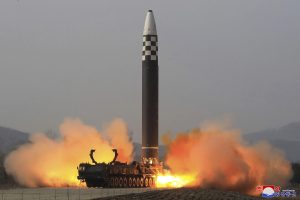On March 24, one week after a similar missile exploded during a test, North Korea successfully fired an intercontinental ballistic missile (ICBM), its first ICBM test since late 2017. Pyongyang claimed that it tested a new type of ICBM called the Hwasong-17 (HS-17) and released footage of the missile being moved to its firing position and launching. However, recent analysis of the footage and satellite imagery casts doubts on whether North Korea successfully tested the HS-17 as it claimed. An anonymous U.S. official recently told the Washington Post that the March 24 test likely used a modified Hwasong-15, which is an older ICBM that North Korea first tested in 2017.
Regardless of which type of ICBM North Korea tested on March 24, the test and the North Korean propaganda surrounding it demonstrate that Kim Jong Un is following through on his January 2022 warning of a return to ICBM testing. It’s also a stark reminder that U.S. dreams of denuclearizing North Korea are untenable.
If North Korea did in fact successfully test the HS-17 like they claimed, it would be the largest ICBM that North Korea has ever tested. Moreover, the data from its alleged flight test suggest that the tested missile, regardless of specific variant, would be able to easily range the entirety of the United States. The most notable feature of the HS-17 is its massive size, which is important because of what overall size suggests about payload or what the missile can carry. A larger missile means more weight, but also more fuel and more and/or larger engines. This, in turn, opens the door for heavier payloads and the ability of a single missile to carry multiple warheads. North Korea is probably facing some engineering challenges with warhead miniaturization — the task of making a nuclear warhead smaller and lighter. However, if the missile has enough power and thrust then difficulties with warhead miniaturization becomes a moot point.
North Korea’s press release describing the HS-17 test does not definitively state whether the missile can carry multiple warheads, but Kim is clearly pursuing this technology.
On February 27 and March 5, North Korea tested unidentified ballistic missiles that the United States later claimed involved the HS-17. North Korea’s messaging around these two earlier tests stated their focus was on evaluating systems for a reconnaissance satellite. American analysts noted that “attitude control devices” mentioned in North Korean statements about the tests could be useful for both satellites and devices for carrying multiple nuclear warheads.
Another indicator of Kim Jong Un’s interest in ICBMs armed with multiple nuclear warheads is the mention of that system in his speech to the Eighth Party Congress in 2021. North Korea has already made progress on testing hypersonic glide vehicles in 2022, a capability mentioned in the same sentence as “multi-warhead rocket” in the speech.
In other words, Kim clearly signaled his intention to develop an ICBM that can carry multiple nuclear warheads. North Korea’s apparent struggles with testing the HS-17 suggest that North Korea has not yet perfected the new ICBM, but its size indicates that it would be capable of carrying multiple warheads even if North Korea struggles with miniaturization.
The steady pace of North Korea’s improving nuclear arsenal paints a very worrying picture about where things are headed on the Korean Peninsula. The United States and North Korea are entering a spiral of slow but steady escalation. North Korea has accelerated its missile testing activities in 2022, and the March 24 test is an example of Kim Jong Un fulfilling his warning about a return to ICBM tests. New construction activities at the Punggye-ri nuclear test site, which North Korea partially demolished in 2018, could be an indication that North Korea plans on reopening the facility. For its part, the United States has responded to the alleged HS-17 test with new sanctions, which are unlikely to dissuade North Korea from future tests.
The good news is that so far this action-reaction cycle has not resulted in a serious increase of tension or risk on the Korean Peninsula. The bad news is that this may not remain the case for much longer.
South Korea’s President-elect Yoon Suk-yeol, who will be sworn into office in May, has signaled he will adopt a more aggressive strategy toward North Korea than his predecessor Moon Jae-in. This will likely take the form of requests for greater demonstrations of U.S. commitment to South Korea’s defense, such as the deployment of more missile defense systems or other strategic capabilities. North Korea will likely respond to such moves by increasing its testing activities, which in turn will increase incentives for counteractions by the United States and South Korea.
Unfortunately, it will be very difficult for the United States to break out of this impending spiral. Backing away from the untenable goal of denuclearization or bust could provide a diplomatic opening, but such a move would not be welcome by U.S. allies that the Biden administration is keen on keeping close. So, if you didn’t get a chance to see the high-resolution pictures of the HS-17 from last week’s test don’t worry, there will probably be many more tests in the future.

































